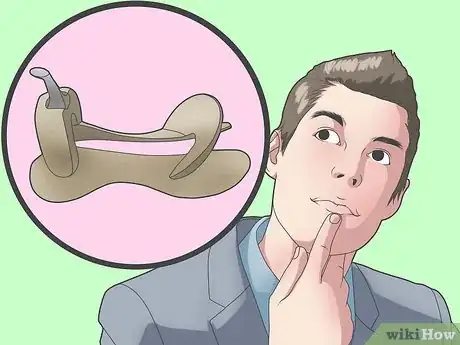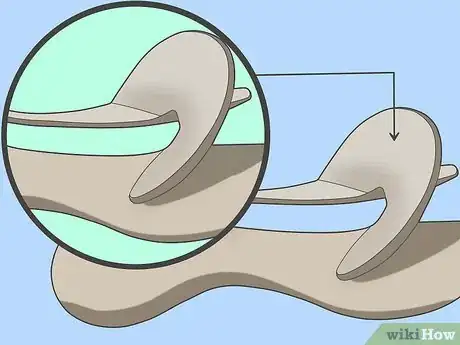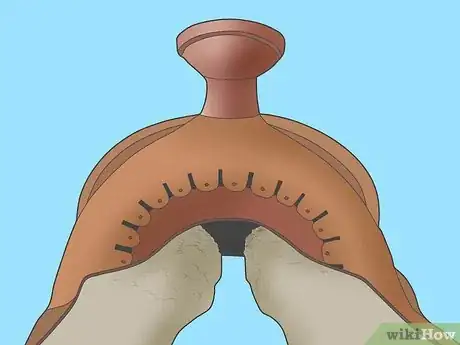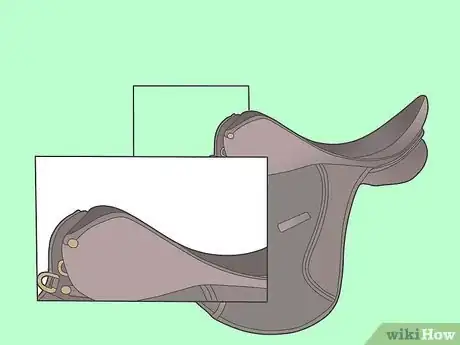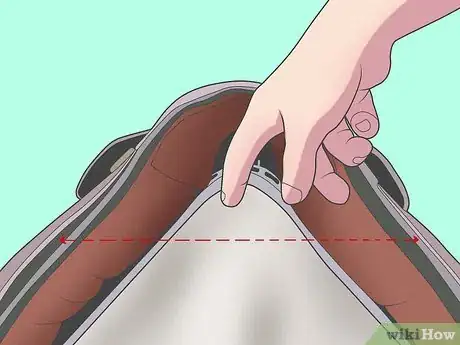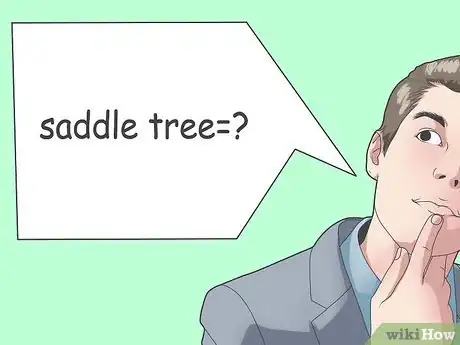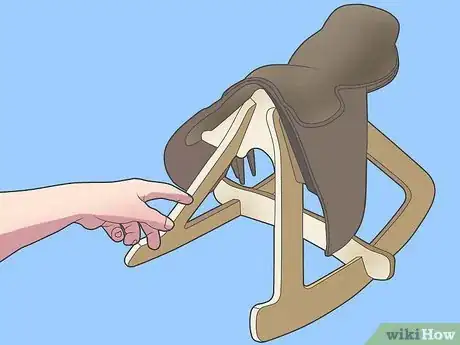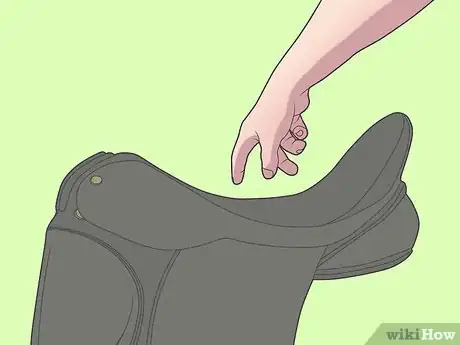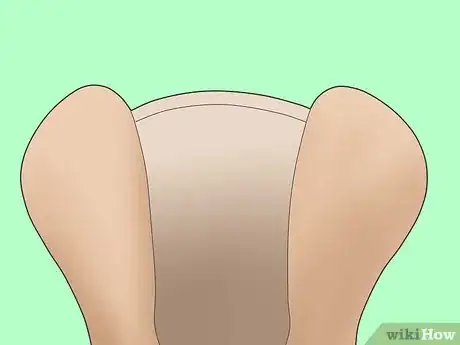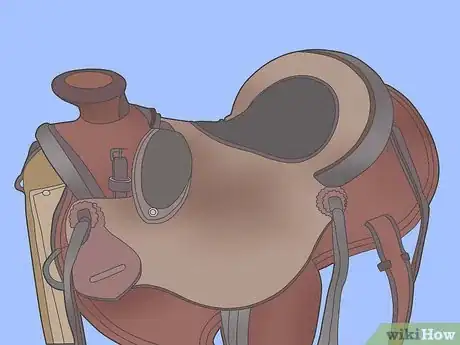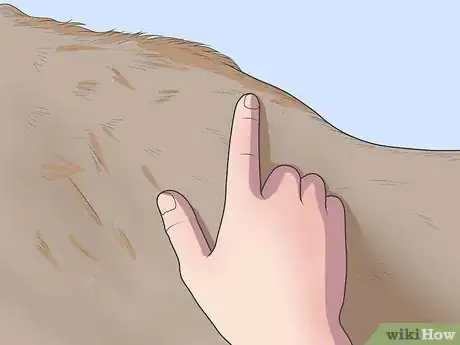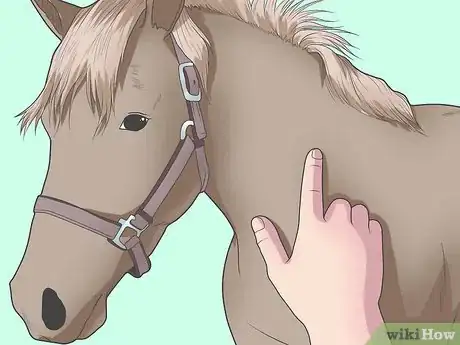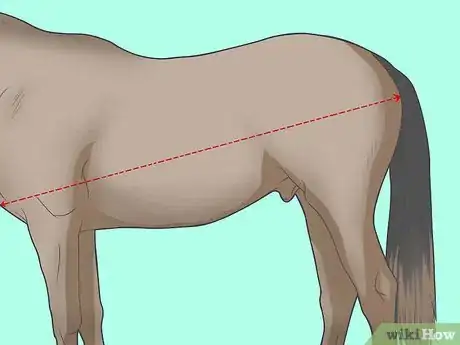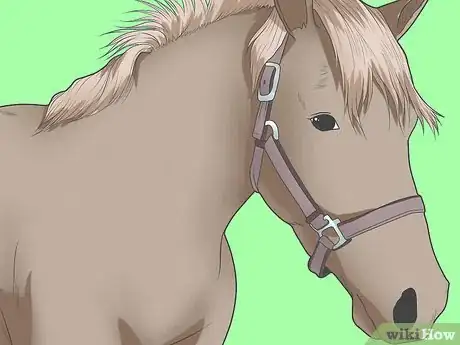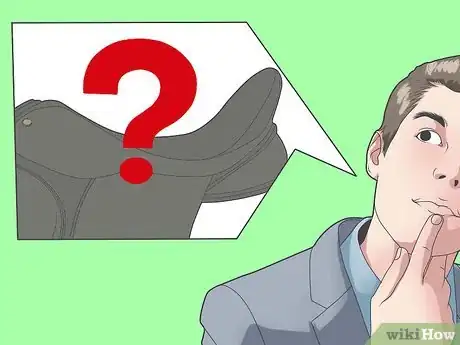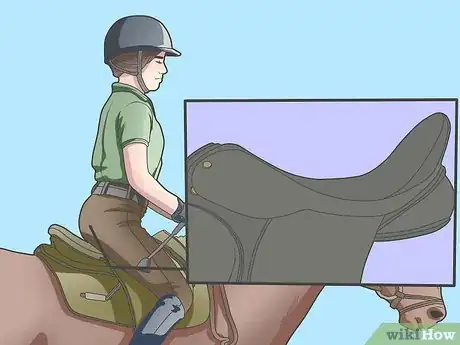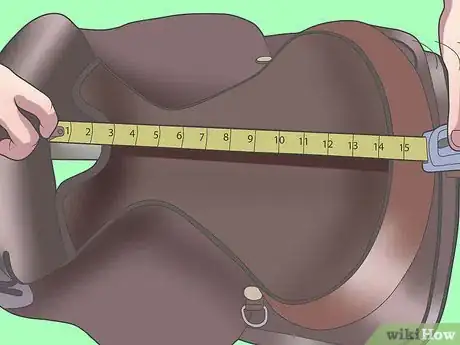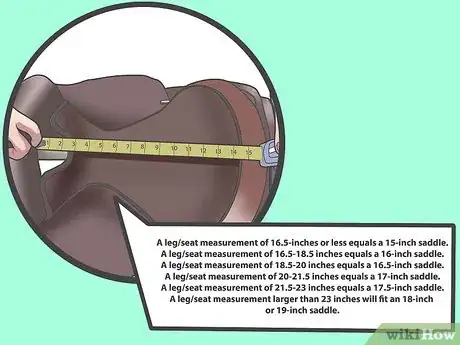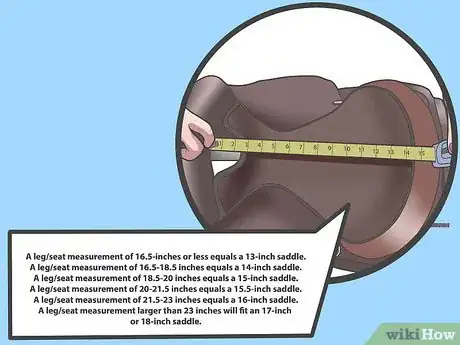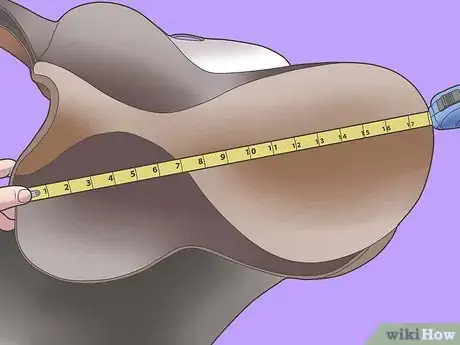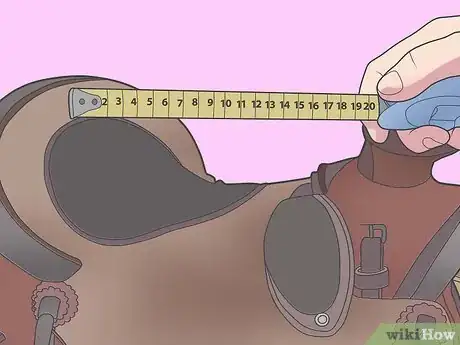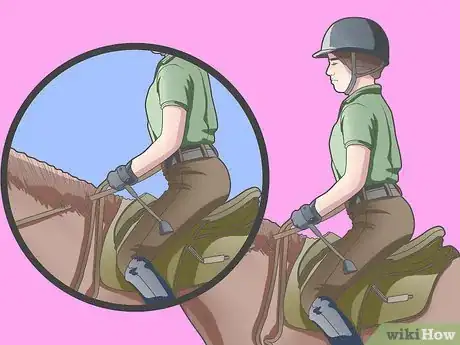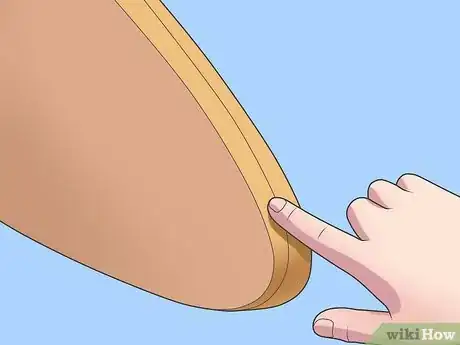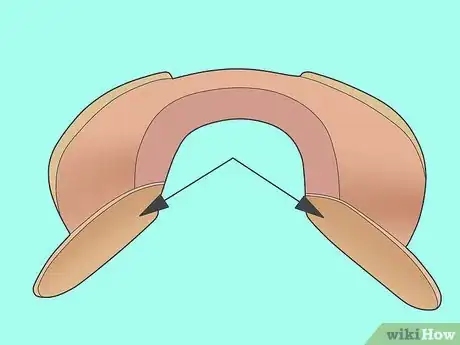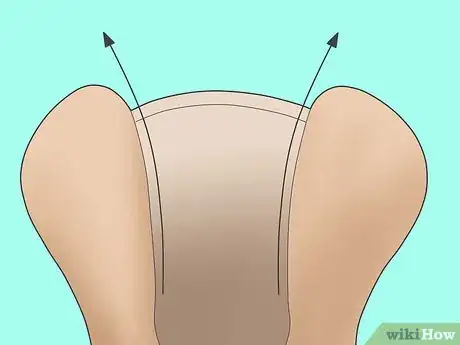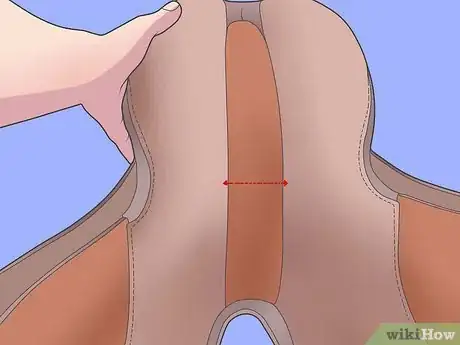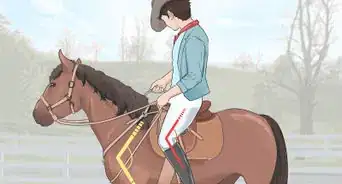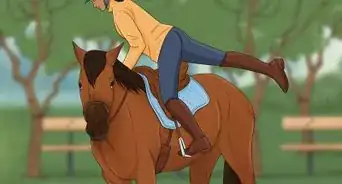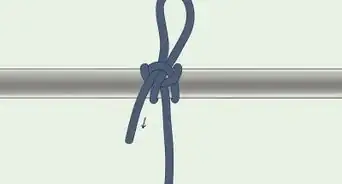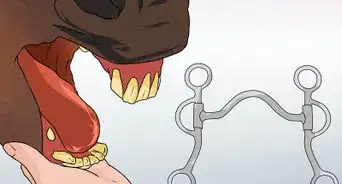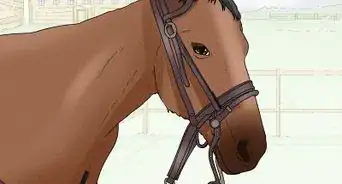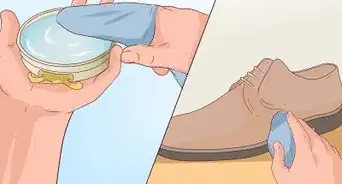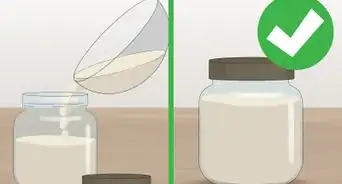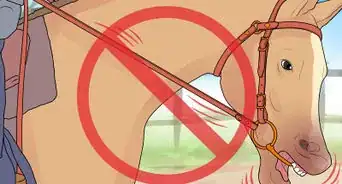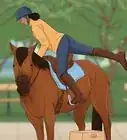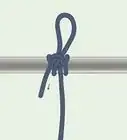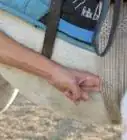X
wikiHow is a “wiki,” similar to Wikipedia, which means that many of our articles are co-written by multiple authors. To create this article, 22 people, some anonymous, worked to edit and improve it over time.
This article has been viewed 283,556 times.
Learn more...
A well-fitting saddle is a staple for easy and enjoyable riding, while keeping your horse safe and comfortable. Unfortunately, finding the perfect saddle isn't a walk in the park. Use this guide to find the perfect saddle for both you and your horse.
Steps
Method 1
Method 1 of 4:
Learning Saddle Terminology
-
1Learn what the bars are. When you’re looking at new saddles, one of the things you’ll need to pay attention to is the bars. The bars are the weight-distributing foundation for the saddle; the part of the saddle that rests on the horse and holds you up. There are two ‘bars’ that distribute weight evenly on either side of the spine. If your saddle is well-fitting, the horse’s back will be in contact with the entire length of the bars.
-
2Locate the cantle. On a saddle, the cantle is the rear section that acts as the back of a seat; it slopes upwards a bit like a chair. The bars are connected to the cantle at the bottom, holding the entire saddle together. The cantle is a term that references both an English and a western saddle.Advertisement
-
3Find the fork of the saddle. On a western saddle, the fork is the section in the front that holds the bars together. It is located underneath the horn, and has the appearance of an upside down ‘U’ shape. There are two primary types of forks - a slick fork and a swell fork. A slick fork is the most popular, and is recognized by sides that angle straight up to the horn. A swell fork is recognized by thicker, curved edges that rise to the horn.
-
4Locate the pommel. On an English saddle, the pommel is the front section of the saddle that holds the bars together. English saddles don’t have horns like western saddles do; they just have a rounded section at the front - the pommel. Think of it as a smaller, rounder version of the cantle.
-
5Find the gullet. Another very important aspect of fitting your saddle to your horse is making sure the gullet fits properly. The gullet refers to the empty space between the bars of the saddle. When the saddle is placed on a horse’s back, you can examine the fit by looking at the gullet from the front and back.
-
6Understand the term ‘saddle tree’. The saddle tree refers to the bars, cantle, fork/pommel, and the gullet. These are the areas that must be examined when sizing a saddle. So when checking your horse for fit, look at the parts of the saddle tree.
-
7Examine the rocker of a saddle. The rocker refers to the angular curve of the bars from the front of the saddle to the back. Imagine it as similar to the shape/angle of the base of a rocking chair. Depending on the shape of the topline of your horse, you will have to try saddles with different rocker angles.
-
8Look at the twist of the saddle. A second important angular measurement of the saddle tree is the twist. This refers to the angle the bars bend outwards; typically they are closer in the middle and further apart at the front and back, like ‘) (‘. Some saddles have wider twists than others, which may affect the measurement for the horse and rider.
-
9Examine the flare of the saddle. The flare of the saddle is the amount the bars of the saddle flare out at the front. This is how much the bars curve upwards at the front and back of the saddle, by the cantle and pommel/fork.
-
10Check out the seat of the saddle. This term is the easiest to recognize; the seat of the saddle is the part that you sit in. The seat has two primary things that should be noted - the length and slope. The length of the seat is how much space it takes up from the front to the back; a well fitting saddle will allow you to sit forward without being pressed against the cantle, and will give about four inches between your position and the front of the fork/pommel. The slope is the angle from the front of the seat to the back, and comes in three options: high, medium, and low. Each slope is found in seats for different types of riding.
Advertisement
Method 2
Method 2 of 4:
Fitting a Saddle for the Horse
-
1Examine your horse’s withers. The withers of the horse is the high point above the shoulder blades along the back. There three general types of withers, which determine the length and rocker angle of the saddle.
- Defined withers are recognizable by a definite high point, and then a gentle slope back to the croup. Most ‘regular’ or ‘medium’ saddles will fit this type of horse.
- Rounded withers occur when, just as it sounds, the withers are gently sloped and the horse has a more flat back. The withers are typically a bit more flat as well, requiring a wider saddle tree.
-
2Look at the horse’s topline. The topline of the horse is the shape/curve of the back from the withers to the croup. The topline has four primary build types: level, straight, swayback, and downhill. Each build will require a different saddle build, or the use of special saddle pads.
- A level topline can be recognized when a horse has withers and croup that are about the same height, and lacks a large dip between the two. Most regular saddles will fit this topline build.
- A straight back is most common in mules, but it sometimes seen in horses. Straight backs occur when the withers and croup are fairly low, and don’t have much of a dip between the two. From the side, their entire back will be almost level. This requires a special ‘straight’ saddle built with bars that lack much of a rocker angle.
- Swayback horses have incredibly prominent, narrow withers and a prominent croup. This typically occurs in horses that are poorly conditioned or that are very old, and makes it so that the saddle cannot sit flat against the back; it balances between the withers and croup. Special pads can be added to fix this problem.
- A downhill topline occurs when the croup of the horse is slightly higher than the withers, causing the saddle to tip forward. You can get a saddle adjusted with more flocking near the front to balance it out, or you can use special pads under the pommel/fork to force the saddle upright.
-
3Look at the length of your horse’s back. A ‘regular’ saddle is built to fit a horse with an average length back. A special saddle is not needed for a horse with a very long back in most cases, but if your horse has a short back, the skirt of the saddle (the leather flaps on either side) might dig into them, causing pain and irritation. If your horse is very small, you may need to get a special ‘small’ saddle to fit their back.
-
4Consider the horse’s age. If you’re buying a saddle for a very young or unconditioned horse, realize that you will likely have to buy a new one in a year or two to fit their growing body. On the other hand, if your horse is very old or overweight, you might need to get another saddle after a year or two to compensate for a lot of weight loss.
Advertisement
Method 3
Method 3 of 4:
Fitting a Saddle for the Rider
-
1Determine the type of saddle you want. Western and English saddles are measured a bit differently, so before you make any measurements it is important to know what type of saddle you are looking for. Additionally, you want to examine the quality and style of the saddle differently depending on the type of work you plan on doing in it.
-
2Consider your body type. Just as most saddles are built for the ‘average’ horse, they are also built to fit the ‘average’ rider. If you are very tall, petite, overweight, or any number of things that affect the overall size/shape of your body, you may need to get a special saddle. Just remember that when you sit in a saddle, the following should occur:
- There should be a four inch space from your body to the front of the swell/pommel.
- You should never be sitting so that you are resting against the cantle or the swell/pommel.
- Your stirrups should fit comfortably without forcing too much bend in the knee.
-
3Take your seat measurement. Sit in a regular chair with your back against the chair back and your feet on the floor. Use a soft measuring tape and measure the distance from your kneecap to the crease in your hip. This can be used in a size converter to determine the size of your saddle.
-
4Determine your size in an English saddle. Use your measurement to determine the seat size (and therefore the saddle size) of an English saddle. The measurement/size approximately equates as:
- A leg/seat measurement of 16.5-inches or less equals a 15-inch saddle.
- A leg/seat measurement of 16.5–18.5 inches (41.9–47.0 cm) equals a 16-inch saddle.
- A leg/seat measurement of 18.5–20 inches (47.0–50.8 cm) equals a 16.5-inch saddle.
- A leg/seat measurement of 20–21.5 inches (50.8–54.6 cm) equals a 17-inch saddle.
- A leg/seat measurement of 21.5–23 inches (54.6–58.4 cm) equals a 17.5-inch saddle.
- A leg/seat measurement larger than 23 inches (58.4 cm) will fit an 18-inch or 19-inch saddle.[1]
-
5Determine your size in a western saddle. The measurement of seat is a bit different for western saddles than it is for English saddles. The easiest conversion is to subtract two inches from the size of your English saddle, and you’ll be left with the size of your western saddle. Use the following chart to determine your Western saddle size based on your leg/seat measurement:
- A leg/seat measurement of 16.5-inches or less equals a 13-inch saddle.
- A leg/seat measurement of 16.5–18.5 inches (41.9–47.0 cm) equals a 14-inch saddle.
- A leg/seat measurement of 18.5–20 inches (47.0–50.8 cm) equals a 15-inch saddle.
- A leg/seat measurement of 20–21.5 inches (50.8–54.6 cm) equals a 15.5-inch saddle.
- A leg/seat measurement of 21.5–23 inches (54.6–58.4 cm) equals a 16-inch saddle.
- A leg/seat measurement larger than 23 inches (58.4 cm) will fit an 17-inch or 18-inch saddle.
-
6Measure the seat of an English saddle. When you’ve gotten your measurement, you can compare that to the seat size of a saddle to determine if it is in your size range. To measure the seat of an English saddle, measure from one of the ‘nails’ to the left or right of the pommel, straight back to the center of the cantle. This will give you the size of the saddle (for example, 16-inches).
-
7Measure the seat of a western saddle. Similar to sizing your seat, the measurement of a western saddle seat is different from an English saddle seat. Using a tape measure or a ruler, measure straight from the base of the pommel to the stitching in the seat. Go to the base of the pommel and measure in a horizontal line straight back.
- Be careful not to touch the saddle pommel when you measure the seat, as the angle of it will give you too large of a measurement. Go to just the base of the pommel along the stitching.
-
8Try on many different saddles. Although your leg/seat measurement and saddle size can be a good indication of a well-fitting saddle, the only way to tell if a saddle truly fits is to sit in it. Try out many different saddles in several different styles to find the best fit and comfort level according to your personal preference. Be sure to adjust the stirrups to their proper length every time you try on a saddle.[2]
- It is better to go with a saddle that is a bit too large than one that is a bit too small. It will be less painful for the horse, and easier for you to ride.
- Bring a trained friend or two along to make sure you are sitting properly in the saddle.
Advertisement
Method 4
Method 4 of 4:
Checking the Saddle’s Fit on Your Horse
-
1Check the bar width. Remember when you checked your horse’s withers and topline? This is when that comes in handy. Place the saddle on your horse without a saddle pad/blanket. If it fits, the bars should be in contact with the horse down the entire length of their back.
- If the bars touch only the base of the horse’s back but not the top, then the saddle is too narrow.
- If the bars touch only the top of the horse’s back but not the bottom, then the saddle is too wide.
-
2Check the bar slope. The slope of the bar is the angle of the rocker against the angle of the horse’s back. A well-fitting saddle will have bars that mimic the angle of the topline. Therefore, the bars will be in contact along the entire strip of the horse’s back.
- If the bars touch only the withers and the croup, then ‘bridging’ will occur and cause sores on the horse. This happens if the bars are too long, or if there isn’t a large enough slope to match the sway of the horse’s back.
- If the bars contact the center of the horse’s back only, then rocking will occur. This happens if the bars are too short or if the slope of the bars is too great to mimic the horse’s back.
-
3Check the bar flare. The angle at which the bars turn upwards/outwards at the front at back of the saddle is the bar flare. If there is little to no bar flare evident, then the saddle may be too small for your horse. Make sure that your saddle has evident bar flare to prevent it from digging into your horse’s back while riding, causing sores or chafing.
-
4Check the gullet. Place the saddle on your horse without a blanket or saddle pad. Look at gullet from the croup of the horse; you should be able to see all the way through to the withers. If you cannot, then the saddle is too small. Then, go to the gullet by the withers and place as many fingers as you can vertically in the empty space. A well-fitting saddle will allow for 2-2.5 fingers to stack in the gullet; more than that means your saddle is too large, while less means that the saddle is too small.[3]
Advertisement
Community Q&A
-
QuestionHow do I measure concho to concho on a western saddle?
 Community AnswerYou don't measure from conchos, but from a point 2" down from the gullet. That still doesn't give a solid, dependable basis for comparing one saddle to another, because the angle of the saddle bars can vary, as can the width and depth of the gullet. You can get an idea of whether a given saddle will fit a given horse, but the only way to truly KNOW is to try it on, and preferably with an experienced saddle fitter to show you how to check it.
Community AnswerYou don't measure from conchos, but from a point 2" down from the gullet. That still doesn't give a solid, dependable basis for comparing one saddle to another, because the angle of the saddle bars can vary, as can the width and depth of the gullet. You can get an idea of whether a given saddle will fit a given horse, but the only way to truly KNOW is to try it on, and preferably with an experienced saddle fitter to show you how to check it. -
QuestionHow do I measure the width of the pommel of an English saddle?
 Community AnswerUse a tape measure and measure from the left side to the right side of the pommel.
Community AnswerUse a tape measure and measure from the left side to the right side of the pommel. -
QuestionAre all cub saddles the same size?
 Community AnswerNo, not all cub saddles are the same size. In most pet stores, you can buy them for different sizes depending on which horse you have (and typically their breed).
Community AnswerNo, not all cub saddles are the same size. In most pet stores, you can buy them for different sizes depending on which horse you have (and typically their breed).
Advertisement
Warnings
- When fitting a saddle to a horse, you cannot rely totally on measurements. Always try the saddle on the horse before purchasing it.⧼thumbs_response⧽
Advertisement
References
About This Article
Advertisement
